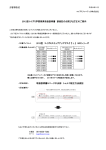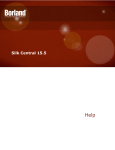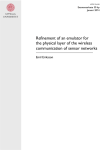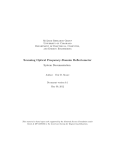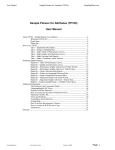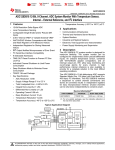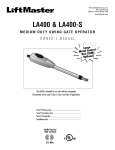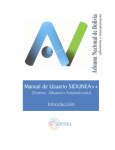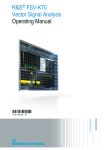Download GTT RBS T - Gefle Testteknik AB
Transcript
GTT RBS TEST SUITE USER GUIDE PROBABLY THE BEST TEST IN THE WORLD Copyright © 2014 Gefle Testteknik AB. All rights reserved. Under the copyright laws, this publication may not be reproduced or transmitted in any form, electronic or mechanical, including photocopying, recording, storing in an information retrieval system, or translating, in whole or in part, without the prior written consent of Gefle Testteknik AB. GTT RBS Test Suite – User Guide V1.0.9 2014-06-10 2 GEFLE TESTTEKNIK RESPECTS THE INTELLECTUAL PROPERTY OF OTHERS, AND WE ASK OUR USERS TO DO THE SAME. GEFLE TESTTEKNIK IS PROTECTED BY COPYRIGHT AND OTHER INTELLECTUAL PROPERTY LAWS. 1 INTRODUCTION ....................................................................................................................................................... 5 2 GTT RBS TEST SUITE OVERVIEW ............................................................................................................................... 5 2.1 GTT LTE RBS TOOLKIT ................................................................................................................................................ 5 2.2 GTT GSM RBS TOOLKIT .............................................................................................................................................. 6 2.3 GTT WCDMA RBS TOOLKIT ........................................................................................................................................ 6 2.4 GTT RBS SMALL CELL TEST........................................................................................................................................... 6 3 SYSTEM REQUIREMENTS.......................................................................................................................................... 7 4 INSTALLATION AND CONFIGURATION ..................................................................................................................... 7 5 4.1 LTE RBS TOOLKIT ....................................................................................................................................................... 7 4.2 GSM & WCDMA RBS TOOLKIT ................................................................................................................................... 7 4.3 GTT RBS SMALL CELL TEST........................................................................................................................................... 8 EVALUATION/ACTIVATION ...................................................................................................................................... 8 5.1 5.1.1 Evaluation........................................................................................................................................................... 8 5.1.2 Online activation ................................................................................................................................................ 8 5.1.3 Offline activation ................................................................................................................................................ 9 5.2 6 EVALUATION/ACTIVATION FOR GTT LTE RBS VERSION 1.1.0 OR NEWER............................................................................... 8 EVALUATION/ACTIVATION FOR OTHER LTE VERSIONS AND GSM/WCDMA PRODUCTS ............................................................ 9 5.2.1 The GTT executables........................................................................................................................................... 9 5.2.2 The GTT LabVIEW libraries ................................................................................................................................. 9 USING GTT RBS TEST SUITE .................................................................................................................................... 10 6.1 GTT LTE RBS TOOLKIT .............................................................................................................................................. 10 6.1.1 Soft Front Panel Settings .................................................................................................................................. 10 6.1.2 Soft Front Panel Measurement Results ............................................................................................................ 16 6.1.3 Measurement definitions according to 3GPP ................................................................................................... 17 6.2 GTT GSM RBS TOOLKIT ............................................................................................................................................ 18 6.2.1 Generation Soft Front Panel ............................................................................................................................. 18 6.2.2 Measurement definitions according to 3GPP ................................................................................................... 25 6.3 GTT WCDMA RBS TOOLKIT ...................................................................................................................................... 26 6.3.1 Generation Soft Front Panel ............................................................................................................................. 26 6.3.2 Analysis Soft Front Panel .................................................................................................................................. 30 GTT RBS Test Suite – User Guide V1.0.9 2014-06-10 3 6.3.3 6.4 Measurement definitions according to 3GPP ................................................................................................... 33 SMALL CELL TEST....................................................................................................................................................... 35 6.4.1 TestStand .......................................................................................................................................................... 35 6.4.2 Measurements ................................................................................................................................................. 39 6.4.3 Additional Functions ......................................................................................................................................... 39 6.5 STATISTICAL TESTING.................................................................................................................................................. 39 6.5.1 Prerequisites ..................................................................................................................................................... 40 6.5.2 Data Storage Requirements ............................................................................................................................. 40 6.5.3 AOQL and Risk Level ......................................................................................................................................... 41 6.5.4 cpk ..................................................................................................................................................................... 41 6.5.5 CSP-1 ................................................................................................................................................................ 43 7 ABBREVIATIONS..................................................................................................................................................... 44 8 REFERENCES ........................................................................................................................................................... 46 APPENDIX A - 3GPP VERSIONS FOR LTE MEASUREMENTS ............................................................................... 47 APPENDIX B - 3GPP VERSIONS FOR GSM MEASUREMENTS .............................................................................. 47 APPENDIX C - 3GPP VERSIONS FOR WCDMA MEASUREMENTS ........................................................................ 47 APPENDIX D ................................................................................................................................................................... 47 LTE ..................................................................................................................................................................................... 48 GSM ................................................................................................................................................................................... 49 WCDMA ............................................................................................................................................................................. 51 GTT RBS Test Suite – User Guide V1.0.9 2014-06-10 4 1 Introduction The GTT RBS Test Suite is a SW-suite for anyone looking for the most efficient usage of National Instruments RF-test HW for testing RBS related products. GTT has created a versatile product suite that will help the users with everything from early verification to full scale production testing. It gives You as a customer the starting point you need for your test setup. GTT can of course assist you with optimization for your specific application. 2 GTT RBS Test Suite Overview The GTT RBS Test Suite is built around a NI PXIe chassis and NI LabVIEW. It consists of NI LabVIEW toolkits for generating and analysing GSM, WCDMA, and LTE downlink signals and supports NI RFSA and RFSG. The GTT RBS Test Suite also includes a test sequence example for a RBS Small Cell and a module for implementing statistical testing. 2.1 GTT LTE RBS Toolkit The GTT LTE RBS Toolkit supports both generation and analysis of LTE signals. Besides the capability of analysing the downlink signal and generating uplink fixed reference signals according to FRC A1-3 (both fully filled and with 25 RBs) for receiver testing, the toolkit also comes with signal generation of downlink according E-UTRA test model (E-TM) 1.1, 1.2, 2, 3.1, 3.2, 3.3 for calibration and/or verification of the setup without a UUT.. The following measurements are supported by the toolkit: - Base station Output Power - Transmit ON/OFF power (PvT, only applied for E-UTRA TDD BS) - Frequency Error (Average Carrier Frequency Offset) - Error Vector Magnitude (EVM) - Occupied Bandwidth (OBW) - Adjacent Channel Leakage Power Ratio (ACLR) - Operating band unwanted emissions - RS TX Power - CCDF (PAR, 0.1%, 0.01%, 0.001%) A more detailed description of the measurements is to be found in ref [1]. For supported 3GPP revisions, see appendix A. GTT RBS Test Suite – User Guide V1.0.9 2014-06-10 5 2.2 GTT GSM RBS Toolkit The GTT GSM RBS toolkit supports both generation and analysis of a GSM signals. Besides the capability of analysing the downlink signal and generating uplink for receiver testing, the toolkit also comes with signal generation of downlink for calibration and/or verification of the setup without a UUT. The user frequency band can be set for the generated signal. The following measurements are supported by the toolkit: - Modulation Accuracy - Transmit Power - Output RF Spectrum - Power Versus Time A more detailed description of the measurements is to be found in ref [2]. For supported 3GPP revisions, see appendix B. 2.3 GTT WCDMA RBS Toolkit The GTT WCDMA RBS toolkit supports both generation and analysis of WCDMA signals. Besides the capability of analysing the downlink signal and generating a 12.2 kbps uplink signal (TC1)for receiver testing, the toolkit also comes with signal generation of downlink signal according to test model (TM) 1, 2, 5 and 6 for calibration and/or verification of the setup without a UUT. The following measurements are supported by the toolkit: - Base station Output Power - Error Vector Magnitude (EVM) - Frequency Error - CPICH Power Accuracy - Adjacent Channel Leakage Power Ratio (ACLR) - Occupied Bandwidth (OBW) - Spectrum Emission Mask (SEM) - Peak Code Domain Error - Relative Code Domain Error (CDR) A more detailed description of the measurements is to be found in ref [3]. For supported 3GPP revisions, see appendix C. 2.4 GTT RBS Small Cell Test The RBS small Cell Test is based on the GTT LTE RBS Toolkit described in section 2.1. The LTE signal generation and analysis parts in the GTT LTE RBS Toolkit are called from the National Instruments TestStand software, see section 6.4 for more information. GTT RBS Test Suite – User Guide V1.0.9 2014-06-10 6 The small cell test comes with a tool for statistical testing. It can, using previously collected data, decide if a certain test must be run or not to assure a set confidence level of the product. This can greatly reduce test times where the product quality is high enough to allow sample testing. See section for 6.5 for more information about the statistical add-on module. 3 System Requirements See http://testteknik.se/content/product for a list of SW and HW requirements for the different products. 4 Installation and Configuration 4.1 LTE RBS Toolkit For version 1.0.1 or older: Run the …\GTT_LTERBS\Volume\ setup.exe For version 1.1.0 or newer: Start LabVIEW and VIPM with administrator rights and start the installation of the “LTE RBS” using VIPM 2014 or newer. The installer for the LTE RBS toolkit includes an installer for the NI LTE toolkit. During the installation process both the LTE RBS toolkit and the NI LTE toolkit are installed. The NI LTE toolkit will ask for a serial number, but it can be left blank. The license status for NI LTE toolkit is overridden by the LTE RBS toolkit, i.e. no separate activation is required for the NI LTE toolkit. See chapter 5.1 for more information. The installed SFPs are by default located at: 32-bit Windows: C:\Program Files\Gefle Testteknik\LTE RBS 64-bit Windows: C:\Program Files (x86)\Gefle Testteknik\LTE RBS The installed APIs are by default located at: …\National Instruments\[LabVIEWInstallDir]\vi.lib\GefleTestteknik\LTERBS\... 4.2 GSM & WCDMA RBS Toolkit Run the …\GTT_GSMWCDMARBS \Volume\ setup.exe The installed SFPs are by default located at: 32-bit Windows: C:\Program Files\Gefle Testteknik\GSMRBS 64-bit Windows: C:\Program Files (x86)\Gefle Testteknik\GSMRBS 32-bit Windows: C:\Program Files\Gefle Testteknik\WCDMARBS 64-bit Windows: C:\Program Files (x86)\Gefle Testteknik\WCDMARBS The installed APIs are by default located at: GTT RBS Test Suite – User Guide V1.0.9 2014-06-10 7 …\National Instruments\LabVIEW 2012\vi.lib\GefleTestteknik\GSMRBS\... …\National Instruments\LabVIEW 2012\vi.lib\GefleTestteknik\WCDMARBS\... 4.3 GTT RBS Small Cell Test Run the …\GTT RBS Small Cell LTE\Installer\Volume1\setup.exe 5 Evaluation/Activation The distributed executables and the GTT LabVIEW libraries (*.lvlib) are licensed and have an evaluation period of 30 days and must then be activated for continued use. The license is locked to the computer that is used during installation. When a product is to be manually activated (i.e. offline), send an email to [email protected] in the following format: Company Name: User Name: Executable User Code 1: Executable User Code 2: LabVIEW Library User Code 1: LabVIEW Library User Code 2: See more information below. The evaluation/activation process is different depending on which product and version that is used. 5.1 Evaluation/Activation for GTT LTE RBS version 1.1.0 or newer Selection of Activation/Evaluation mode of the LabVIEW libraries and the executable is done from a “Third Party Add-ons” dialog box inside LabVIEW. This one is shown automatically when LabVIEW is started and can also be reached from following menu inside LabVIEW: Help -> Activate Add-ons. 5.1.1 Evaluation If Evaluation mode is wanted, no particular action is necessary. Simply click “Continue to LabVIEW”. 5.1.2 Online activation Open the “Third Party Add-ons” dialog box inside LabVIEW and select “Activate Add-ons”. In the next dialog box, select the GTT toolkit you wish to activate and press “Next”. In the next Dialog box, select “Automatically activate through an Internet connection” and press “Next”. In the next dialog box enter the LicenseID and password you got when you bought the product and press “Activate”. GTT RBS Test Suite – User Guide V1.0.9 2014-06-10 8 5.1.3 Offline activation Open the “Third Party Add-ons” dialog box inside LabVIEW and select “Activate Add-ons”. In the next dialog box, select the GTT toolkit you wish to activate and press “Next”. In the next Dialog box, select “Use a Web browser on this or another computer to acquire an activation code” and press “Next”. In the next dialog box, send these two “LabVIEW User Codes” to [email protected], using the mail template above. GTT will send back two activation codes. Copy these two into the Activation Code 1 and 2 and press “Activate”. 5.2 Evaluation/Activation for other LTE versions and GSM/WCDMA products 5.2.1 The GTT executables As long as a GTT executable is not activated, a dialog box is shown each time the executable is started. In this dialog box the user can select “Evaluation” or “Activate”. 5.2.1.1 Evaluation If Evaluation mode is wanted, no particular action is necessary. Simply click “Evaluation” to run the application in evaluation mode. 5.2.1.2 Activation If a license is purchased, select “Activation” and a new dialog is shown with two User Codes. Send these two “Executable User Code” to [email protected], using the mail template above. GTT will send back two activation codes. Copy these two into the Activation Code 1 and 2 and press “Continue”. 5.2.2 The GTT LabVIEW libraries Selection of Activation/Evaluation mode of the LabVIEW libraries is done from a “Third Party Add-ons” dialog box inside LabVIEW. This one is shown automatically when LabVIEW is started and can also be reached from following menu inside LabVIEW: Help -> Activate Add-ons. 5.2.2.1 Evaluation If Evaluation mode is wanted, no particular action is necessary. Simply click “Continue to LabVIEW”. 5.2.2.2 Activation If a license is purchased, select “Activate Add-ons”. In the next dialog box, select the GTT toolkit you wish to activate and press “Next”. In the next Dialog box, select “Use a Web browser on this or another computer to acquire an activation code” and press “Next”. In the next dialog box, send these two “LabVIEW Library User Code” to [email protected], using the mail template above. GTT will send back two activation codes. Copy these two into the Activation Code 1 and 2 and press “Activate”. GTT RBS Test Suite – User Guide V1.0.9 2014-06-10 9 6 Using GTT RBS Test Suite 6.1 GTT LTE RBS Toolkit 6.1.1 Soft Front Panel Settings The LTE soft front panel is started from Windows Start -> Program -> Gefle Testteknik -> LTE RBS -> LTERBS. The SFP window appears: Figure 6-1: Settings Tab 6.1.1.1 Acquisition section RFSA name: Analysis device, VST in this case. Clock source: Reference clock source to the VST on board PLL (Phase Lock Loop). GTT RBS Test Suite – User Guide V1.0.9 2014-06-10 10 On board clock – Selects internal 20 MHz clock Ref In – Selects reference clock in front. PXI Clock 10 – Selects 10 MHz clock from the PCI Express backplane. ClkIn – This configuration does not apply to the NI 5644R/5645R (See NI documentation for more information). Figure 6-2: RFSA Settings RFSA settings: Center Frequency: Center frequency of the LTE signal. Reference Level: LTE signal reference level External Attenuation, dB: Attenuation in the signal path that must be taken in notice. Auto Level: If true, the system sets the best reference level based on the peak power of the measured signal. If false, the value in the Reference Level settings is used. Figure 6-3: LTE Signal Settings LTE signal settings: Duplex Mode DL: Selects if the Down Link (DL) signal to be analysed is FDD or TDD mode. System Bandwidth DL: Selects the bandwidth of the DL signal to be analysed. Downlink Test Model: Selects the test model of the DL signal to be analysed. GTT RBS Test Suite – User Guide V1.0.9 2014-06-10 11 Figure 6-4: Advanced Settings Advanced Settings: Measurements offset (slots): Set on which slot the analysis of the signal shell start. Number of averages: Set the number of averages that should be analysed. Measurement length (slots): Set how many slots the analysis should be performed at. Cell ID: Sets the Cell ID of the signal. EVM measurement unit: Selects if the result should be presented in % or dB. # of Antennas: Specifies the number of antennas used for the transmission/reception of the LTE signal. Preferred Sync Method: Specifies the antenna ports on which the P-SS and the S-SS are transmitted. Sync Signal Port: Specifies the antenna ports on which the P-SS and the S-SS are transmitted. ACP Sweep Time (sec): Sets the measurement length for ACP. SEM Measurement Length (sec): Sets the measurement length for SEM. SEM Meas Results Type: Specifies the type of the measurement results for the SEM measurement, Total Power Reference or Power Spectral Density Reference. SEM All Traces Enabled: Specifies whether to enable all the traces SEM measurement. GTT RBS Test Suite – User Guide V1.0.9 2014-06-10 12 Figure 6-5: BS Settings for Unwanted emissions BS Settings for Unwanted emissions: settings for the SEM measurement see ref [1] for details of what settings is suitable for the UUT. Figure 6-6: Enable Enable: enable which measurements to perform. Figure 6-7: Message Message: displays all errors and warnings. 6.1.1.2 Generation section Center Frequency (Hz): Center frequency of the LTE signal. GTT RBS Test Suite – User Guide V1.0.9 2014-06-10 13 Average Power (dBm): Sets the signal output level. The actual signal level is the power level plus the external attenuator. RFSG Name: Generation device, VST (PXIe-5644/5645R) is required for generation. Pre-filter Gain (dB): Specifies the AWG pre-filter gain. Figure 6-8: Trigger Config Trigger Config: Type: Immediate – No start trigger is configured. Start Trigger – Enables trigger functionality. Restart Trigger – This will restart the capturing of the trigger and signal generation. Note: Start Trigger Delay must be set to at least 10 us. Source: Trigger input select. PFI0-2 is valid for PXI-5644/5645R. PF0 is located at the front of the VST, PF1 and PF2 on digital IO connector. Edge: Rising edge/Falling edge, selects on which edge the trigger shall be detected. PFI Min Pulse Width: Specifies the minimal pulse width in seconds for the PFI lines. Start Trigger Delay: A configurable trigger delay up to 35 seconds before the generation starts. GTT RBS Test Suite – User Guide V1.0.9 2014-06-10 14 Generation mode: Read From File: Select to read IQ data from a file. The file format should be TDMS and it should be interleaved IQ format, i.e. first column with I and second with Q. Figure 6-9: File Settings Path: Select the IQ file to be used. Sample rate file: Set the sample rate for the IQ data in the file (ex 15.36M). UL Generate: Build the uplink signal to generate. Figure 6-10: UL Generate Settings System Bandwidth (Hz): Set the bandwith of the signal, 1.4MHz - 20MHz. Basband Filter Enabled: Enable baseband filter. Cell ID: Sets the Cell ID of the signal. Duplex mode UL: Sets the duplex mode of the signal, FDD or TDD. Uplink FRC: Select FRC model, A1-1 – A1-5. Uplink RNTI: Set the RNTI of the signal. Fully filled: Select if the FRC A1-3 should fully filled or have 25RBs. DL for loopback: Available for testing the whole system, using a loop cable between RF out and RF in. GTT RBS Test Suite – User Guide V1.0.9 2014-06-10 15 Figure 6-11: DL for loopback Settings 6.1.2 Soft Front Panel Measurement Results Figure 6-12: Measurement Results tab. GTT RBS Test Suite – User Guide V1.0.9 2014-06-10 16 6.1.3 6.1.3.1 Measurement definitions according to 3GPP Base station output power (Channel Power in SFP) The test purpose is to verify the accuracy of the maximum output power across the frequency range and under normal and extreme conditions for all transmitters in the BS. 6.1.3.2 Frequency error (Average Carrier Frequency Offset in SFP) Frequency error is the measuring of the difference between the actual BS transmit frequency and the assigned frequency. The same source shall be used for RF frequency and data clock generation. 6.1.3.3 EVM (Error Vector Magnitude) The Error Vector Magnitude is a measure of the difference between the ideal symbols and the measured symbols after the equalization. This difference is called the error vector. The EVM result is defined as the square root of the ratio of the mean error vector power to the mean reference power expressed in percent. 6.1.3.4 DL RS power (RX TX Power in SFP) DL RS power is the resource element power of Downlink Reference Symbol. 6.1.3.5 Occupied bandwidth (OBW Spectrum Trace in SFP) The occupied bandwidth is the width of a frequency band such that, below the lower and above the upper frequency limits, the mean powers emitted are each equal to a specified percentage /2 of the total mean transmitted power. The test purpose is to verify that the emission of the BS does not occupy an excessive bandwidth for the service to be provided and is, therefore, not likely to create interference to other users of the spectrum beyond undue limits. 6.1.3.6 Adjacent Channel Leakage power Ratio (ACP relative power in SFP) Adjacent Channel Leakage power Ratio (ACLR) is the ratio of the filtered mean power centred on the assigned channel frequency to the filtered mean power centred on an adjacent channel frequency. 6.1.3.7 Operating band unwanted emissions (SEM measurements in SFP) This test measures the emissions of the BS, close to the assigned channel bandwidth of the wanted signal, while the transmitter is in operation. 6.1.3.8 Complementary Cumulative Distribution Function (CCDF measurements in SFP) This test measures the complementary cumulative distribution function (CCDF) of the RF signal, peak power and average power. GTT RBS Test Suite – User Guide V1.0.9 2014-06-10 17 6.2 GTT GSM RBS toolkit 6.2.1 Generation Soft Front Panel The soft front panel for GSM signal generation is started from Windows Start -> Program -> Gefle Testteknik -> GSMRBS -> GSMRBSGen. The generation window appears: Figure 6-13: the GSM signal generation front panel There are a number of settings for the signal generation: RFSG Handle In: Generation device, VST (PXIe-5644/5645R) is required for generation. External Attenuation, dB: Attenuation in the signal path that must be taken into account. Average Power, dBm: Sets the signal output level. The actual signal level is the power level plus the external attenuation. GTT RBS Test Suite – User Guide V1.0.9 2014-06-10 18 Figure 6-14: UUT settings UUT settings: UUT: Select UUT, BTS = Base Transceiver Station, MS = Mobile Station. Band: Selection of the GSM frequency band. ARFCN: Absolute Radio Frequency Channel Number. The interval of this number depends on the frequency band. Figure 6-15: Trigger settings Trigger settings: Type: Immediate – No start trigger is configured. Start Trigger – Enables trigger functionality. Restart Trigger – This will restart the capturing of the trigger and signal generation. Note: Start Trigger Delay must be set to at least 10 us. Source: Trigger input select. PFI0-2 is valid for PXI-5644/5645R. PF0 is located at the front of the VST, PF1 and PF2 on digital IO connector. Edge: Selects which edge, rising or falling, on which the trigger should be detected. PFI Min Pulse Width: Specifies the minimal pulse width in seconds for the PFI lines. GTT RBS Test Suite – User Guide V1.0.9 2014-06-10 19 Start Trigger Delay: A configurable trigger delay up to 35 seconds before the generation starts. Figure 6-16: Frequency reference settings Frequency reference settings: Reference Source: Reference clock source to the VST on board PLL (Phase Lock Loop) On board clock – Selects internal 20 MHz clock. Ref In – Selects reference clock in front. PXI Clock 10 – Selects 10 MHz clock from the PCI Express backplane. Frequency, Hz: When the reference source above is set to “Ref In” this parameter sets the frequency of the incoming clock. Backplane Source: Sets the signal to drive the 10 MHz reference clock in PXI backplane. This functionality is only supported for PXI-5610, PXI-5670 and PXI-5671. Figure 6-17: Generate Generate: Signal: NB slot 0 – Normal burst for slot 0, all other slots idle data. NB slot 1 – Normal burst for slot 1, all other slots idle data. NB all slots – Normal burst for slot 0-7. From file: GTT RBS Test Suite – User Guide V1.0.9 2014-06-10 20 Figure 6-18: File Path: Path to IQ file. Sample rate: Signal sample rate. To start the generation of the GSM signal, press the symbol. If the green LED in the front panel is enabled the generation has started. To stop the generation, press the symbol. If a setting is changed during generation, the apply the changes. 6.2.1.1 symbol must be pressed to Analysis Soft Front Panel The soft front panel for the GSM signal analysis is started from Windows Start -> Program > Gefle Testteknik -> GSMRBS -> GSMRBSAnalysis. The analysis window appears: GTT RBS Test Suite – User Guide V1.0.9 2014-06-10 21 Figure 6-19: Soft front panel analysis window 6.2.1.2 Front panel settings To the left in the soft front panel the settings pane appears and to the right the results of the different measurements. There are a number of settings for the signal generation: RFSA Handle In: Analysis device: VST in this example. GTT RBS Test Suite – User Guide V1.0.9 2014-06-10 22 Figure 6-20: RFSA settings RFSA settings: Center Frequency: Center frequency of the GSM signal. Reference Level: GSM signal reference level External Attenuation, dB: Attenuation in the signal path that must be taken into account. Auto Level: If true, the system uses the best reference level based on the peak power of the signal measured. If false, the value in the Reference Level settings is used. Figure 6-21: BS settings BS settings: UUT: Select UUT, BTS = Base Transceiver Station, MS = Mobile Station. Band: Selection of the GSM frequency band. ARFCN: Absolute Radio Frequency Channel Number. The interval of this number depends on the frequency band. GTT RBS Test Suite – User Guide V1.0.9 2014-06-10 23 Burst Sync: Method to synchronize to the data burst. Can be set to None (no sync), Amplitude (-20 dB threshold) or Training sequence. Averages: On/Off, if set to On the number of averages is set to 200 (this setting is valid for OFRS and EVM measurements) Frequency Reference settings: Figure 6-22: Frequency Reference settings Reference Source: Reference clock source to the VST on board PLL (Phase Lock Loop) On board clock – Selects internal 20 MHz clock Ref In – Selects reference clock in front of the VST PXI Clock 10 – Selects 10 MHz clock from the PCI Express backplane. Frequency, Hz: When the reference source above is set to ‘Ref In’ this parameter sets the frequency of the incoming clock. Backplane Source: Sets the signal to drive the 10 MHz reference clock in PXI backplane. This functionality is only supported for PXI-5610, PXI-5670 and PXI-5671. Figure 6-23: Trigger settings Trigger settings: Source: Immediate – No triggering is used External – Not used Software – Not used RTSI0-7 – PXI trigger 0-7 PFI0-2 – PFI0 in the front of PXIe-5644R, PFI1-2 in the backplane. GTT RBS Test Suite – User Guide V1.0.9 2014-06-10 24 Power – Power level trigger (Level parameter below) Edge: Selects which edge, rising or falling, on which the trigger shall be detected. Delay, sec: Specifies the time between the trigger event and the start of data acquisition. Level, dBm: The level to use for power triggering (includes any external attenuation). Min Quiet Time, sec: Specifies the minimum time the signal must remain below the trigger level in order for the trigger to work. To start a capture of a WCDMA signal, press the 6.2.1.3 symbol. Front panel measurements The measurements results will be found in the different front panel tabs: - EVM, modulation accuracy measurements - TXP, Transmit Power measurement - ORFS, Output RF Spectrum measurement - PvT, Power versus Time measurements In section 6.2.2 below there is a more detailed description of each measurement. 6.2.2 6.2.2.1 Measurement definitions according to 3GPP Mean Transmitted RF Carrier Power (TXP tab in SFP) To verify the accuracy of the mean transmitted RF carrier power across the frequency range and at each power step. 6.2.2.2 Modulation accuracy EDGE (EVM tab in SFP) The test purpose is: 1. To verify the correct implementation of the pulse shaping filtering. 2. To verify that at GMSK modulation the phase error during the active part of the time slot does not exceed the specified limits under normal and extreme test conditions and when subjected to vibration. 3. To verify that the frequency error during the active part of the time slot does not exceed the specified limits under normal and extreme test conditions and when subjected to vibration. GTT RBS Test Suite – User Guide V1.0.9 2014-06-10 25 4. To verify that at supported modulations 8-PSK, QPSK, AQPSK, 16-QAM and 32-QAM the Error Vector Magnitude (EVM) and the origin offset during the active part of the time slot do not exceed the specified limits under normal and extreme test conditions and when subjected to vibration. Note: All TRXs in the configuration shall be switched on transmitting full power in all time slots for at least 1 hour before starting the test. 6.2.2.3 Transmitted RF carrier power versus time (PvT tab in SFP) The test purpose is to verify: 1. The time during which the transmitted power envelope should be stable (the useful part of the time slot); 2. The stability limits; 3. The maximum output power when nominally off between time slots. 6.2.2.4 Spectrum due to modulation and wideband noise (ORFS tab in SFP) The purpose of this measurement is to verify that the output RF spectrum due to modulation and wideband noise does not exceed the specified levels for an individual transceiver. The system under test shall be tested with one TRX active or with the BTS equipped with only one TRX, at three frequencies (first at RF channel B, second at RF channel M and third at RF channel T). Slow frequency hopping shall be disabled. 6.2.2.5 Switching transients spectrum (ORFS tab in SFP) The purpose of this measurement is to verify the level of the switching transients in the output RF spectrum. 6.3 GTT WCDMA RBS toolkit 6.3.1 Generation Soft Front Panel The soft front panel for WCDMA signal generation is started from Windows Start -> Program -> Gefle Testteknik -> WCDMARBS -> WCDMARBSGen. The generation window appears: GTT RBS Test Suite – User Guide V1.0.9 2014-06-10 26 Figure 6-24: the WCDMA signal generation front panel There are a number of settings for the signal generation: RFSG Handle In: Generation device, VST (PXIe-5644/5645R) is required for generation. External Attenuation, dB: Attenuation in the signal path that must be taken into account. Average Power, dBm: Sets the signal output level. The actual signal level is the power level plus the external attenuator. Center Frequency, Hz: Carrier frequency set. GTT RBS Test Suite – User Guide V1.0.9 2014-06-10 27 Figure 6-25: Trigger settings Trigger settings: Type: Immediate – No start trigger is configured. Start Trigger – Enables trigger functionality. Restart Trigger – This will restart the capturing of the trigger and signal generation. Note: Start Trigger Delay must be set to at least 10 us. Source: Trigger input select. PFI0-2 is valid for PXI-5644/5645R. PF0 is located at the front of the VST, PF1 and PF2 on digital IO connector. Edge: Rising edge/Falling edge, selects on which edge the trigger shall be detected. PFI Min Pulse Width: Specifies the minimal pulse width in seconds for the PFI lines. Start Trigger Delay: A configurable trigger delay up to 35 seconds before the generation starts. Figure 6-26: Frequency reference settings Frequency reference settings: Reference Source: Reference clock source to the VST onboard PLL (Phase Lock Loop) Onboard clock – Selects internal 20 MHz clock. Ref In – Selects reference clock in front. GTT RBS Test Suite – User Guide V1.0.9 2014-06-10 28 PXI Clock 10 – Selects 10 MHz clock from the PCI Express backplane. Frequency, Hz: When the reference source above is set to “Ref In” this parameter sets the frequency of the incoming clock. Backplane Source: Sets the signal to drive the 10 MHz reference clock in PXI backplane. This functionality is only supported for PXI-5610, PXI-5670 and PXI-5671. Figure 6-27: Generate Generate: Signal: Signal type. TM1, TM2, TM5 or TM6 for downlink and TC1 for uplink (12.2 kbps, DPCCH: SF = 256, Code = 0, -6.5 dBc, DPDCH, SF = 64, Code = 16, -1.1 dBc, I). Scramble Code: Scramble code number. From file: Figure 6-28: Generation file path Path: Path to IQ file. Sample rate: Signal sample rate To start the generation of the WCDMA signal, press the symbol. If the green LED in the front panel is enabled the generation has started. To stop the generation, press the symbol. If a setting is changed during generation, the apply the changes. GTT RBS Test Suite – User Guide V1.0.9 2014-06-10 symbol must be pressed to 29 6.3.2 Analysis Soft Front Panel The soft front panel for WCDMA signal analysis is started via Windows Start -> Program -> Gefle Testteknik -> WCDMARBS -> WCDMARBSAnalysis. The analysis window appears: Figure 6-29: the WCDMA signal analysis front panel 6.3.2.1 Front panel settings To the left in the soft front panel the settings pane appears and to the right the results of the different measurements. There are a number of settings for the signal generation: RFSA Handle In: Analysis device, VST in this case. GTT RBS Test Suite – User Guide V1.0.9 2014-06-10 30 Figure 6-30: RFSA settings RFSA settings: Center Frequency: Center frequency of the WCDMA signal. Reference Level: WCDMA signal reference level External Attenuation, dB: Attenuation in the signal path that must be taken into account. Auto Level: If true, the system sets the best reference level based on the peak power of the signal measured. If false, the value in the Reference Level settings is used. Figure 6-31: BS settings BS (Base Station) settings: UUT: Select if the UUT is a BS or UE (User Equipment) BS maximum output power: Set the maximum output power for the UUT, needed to set the correct SEM mask parameters. Symbol Boundary: Test channel selection: Auto, User or a specific test model. Frequency Reference settings: Figure 6-32: Frequency Reference settings GTT RBS Test Suite – User Guide V1.0.9 2014-06-10 31 Reference Source: Reference clock source to the VST onboard PLL (Phase Lock Loop) Onboard clock – Selects internal 20 MHz clock Ref In – Selects reference clock in front. PXI Clock 10 – Selects 10 MHz clock from the PCI Express backplane. Frequency, Hz: When the reference source above is set to “Ref In” this parameter sets the frequency of the incoming clock. Backplane Source: Sets the signal to drive the 10 MHz reference clock in PXI backplane. This functionality is only supported for PXI-5610, PXI-5670 and PXI-5671. Figure 6-33: Trigger settings Trigger settings: Source: Immediate – No triggering is used External – Not used Software – Not used RTSI0-7 – PXI trigger 0-7 PFI0-2 – PFI0 in the front of PXIe-5644R, PFI1-2 in the backplane. Power – Power level trigger (Level parameter below) Edge: Rising/Falling, selects on which edge the trigger shall be detected. Delay, sec: Specifies the amount of additional time after the trigger event before acquire data. Level, dBm: The level to use for power triggering (includes any external attenuation). Min Quiet Time, sec: Specifies the minimum time below the trigger value the signal must remain in order to trigger. GTT RBS Test Suite – User Guide V1.0.9 2014-06-10 32 To start a capture of a WCDMA signal, press the 6.3.2.2 symbol. Front panel measurements The measurements results will be found in the different front panel tabs: - ACP (ACLR), Adjacent Channel Leakage Power measurements - ModAcc (EVM), Modulation Accuracy measurements - CDP, Code Domain Power measurements - SEM, Spectrum Emission Mask - CHP & OBW, Channel Power and Occupied Bandwidth measurements In section 6.3.3 below there is a more detailed description of each measurement. 6.3.3 6.3.3.1 Measurement definitions according to 3GPP Base station Maximum Output Power (CHP tab in SFP) Maximum output power, Pmax, of the base station is the mean power level per carrier measured at the antenna connector in specified reference condition. The test purpose is to verify the accuracy of the maximum output power across the frequency range and under normal and extreme conditions for all transmitters in the BS. 6.3.3.2 Primary CPICH Power accuracy (CDP tab in SFP) Primary CPICH (P-CPICH) power is the code domain power of the Primary Common Pilot Channel. P-CPICH power is indicated on the BCH. The requirement is applicable for all BS types. The purpose of the test is to verify, that the BS under test delivers Primary CPICH code domain power within margins, thereby allowing reliable cell planning and operation. 6.3.3.3 Frequency error (ModAcc tab in SFP) Frequency error is the measuring of the difference between the actual BS transmit frequency and the assigned frequency. The same source shall be used for RF frequency and data clock generation. The purpose of this measurement is to verify that the Frequency Error is not too high. 6.3.3.4 Occupied bandwidth (OBW tab in SFP) The occupied bandwidth is the width of a frequency band such that, below the lower and above the upper frequency limits, the mean powers emitted are each equal to a specified percentage /2 of the total mean transmitted power. The value of /2 shall be taken as 0.5%. GTT RBS Test Suite – User Guide V1.0.9 2014-06-10 33 The test purpose is to verify that the emission of the BS does not occupy an excessive bandwidth for the service to be provided and is, therefore, not likely to create interference to other users of the spectrum beyond undue limits. 6.3.3.5 ACLR (ACP tab in SFP) Adjacent Channel Leakage power Ratio (ACLR) is the ratio of the RRC filtered mean power centred on the assigned channel frequency to the RRC filtered mean power centred on an adjacent channel frequency. 6.3.3.6 Peak code Domain error (ModAcc tab in SFP) The Peak Code Domain Error is computed by projecting the error vector (EVM) onto the code domain at a specific spreading factor. The Code Domain Error for every code in the domain is defined as the ratio of the mean power of the projection onto that code, to the mean power of the composite reference waveform. This ratio is expressed in dB. The Peak Code Domain Error is defined as the maximum value for the Code Domain Error for all codes. The measurement interval is one timeslot as defined by the C-PICH (when present), otherwise the measurement interval is one timeslot starting with the beginning of the SCH. It is the purpose of this test to discover and limit inter-code cross-talk. 6.3.3.7 Relative Code Domain Error (ModAcc tab in SFP) The Relative Code Domain Error is computed by projecting the error vector (EVM) onto the code domain at a specified spreading factor. Only the active code channels in the composite reference waveform are considered for this requirement. The Relative Code Domain Error for every active code is defined as the ratio of the mean power of the error projection onto that code, to the mean power of the active code in the composite reference waveform. This ratio is expressed in dB. The measurement interval is one frame. The requirement for Relative Code Domain Error is only applicable for 64QAM modulated codes. 6.3.3.8 EVM The Error Vector Magnitude is a measure of the difference between the reference waveform and the measured waveform. This difference is called the error vector. 6.3.3.9 Spectrum emission mask (SEM in SFP tab) The mask defined in ref [3] may be mandatory in certain regions. In other regions this mask may not be applied. For regions where this clause applies, the requirement shall be met by a base station transmitting on a single RF carrier configured in accordance with the manufacturer's specification. In addition, for a BS operating in non-contiguous spectrum, the requirements apply inside any sub-block gap. This test measures the emissions of the BS, close to the assigned channel bandwidth of the wanted signal, while the transmitter is in operation. GTT RBS Test Suite – User Guide V1.0.9 2014-06-10 34 6.4 Small Cell Test 6.4.1 TestStand TestStand is a test management software used to develop automated test systems. Test sequences are used to call the different VIs to be able to generate and analyse signals. Below is an example of a LTE test sequence. This example can be installed and tested, see section 4 for further information how to install it. 6.4.1.1 Main test sequence Open the TestStand software and select File -> Open file, and select the sequence file: ..\Installation directory\RBS Small Cell LTE\Small Cell LTE.seq. Figure 6-34: LTE test sequence example GTT RBS Test Suite – User Guide V1.0.9 2014-06-10 35 The sequence contains three sections, setup, main and clean-up. The setup section configures the hardware parts in the PXI chassis for multi DUT handling. It is possible to select if a LTE signal should be generated or not. The value is by default set to true but can be switched off by setting the variable LteSigGen to False. In the main part of the test sequence the LTE signal is generated (if enabled) according to the different test models, see [1]. The signal from DUT is then analysed for each test model according to [1]. In the example two measurement loops are performed. For each measurement loop a unique configuration file and a test limits file is loaded. When all measurements are done the HW used is closed. 6.4.1.2 Other sequences Except the main sequences, a few other sequences are used. Figure 6-35: Test sequences before and after test 6.4.1.3 - PreUUT: For all new DUTs to be tested a dialog box will appear where DUT serial number can be written. Another dialog box demands the user to select which DUT input to use (multiplexer input in the PXIe-1082 chassis). - PostUUT: Actions that will be done after the main test sequence. In this case a check is performed to see if a self-calibration of the VST is necessary. - PreUUTLoop: Actions to be done in the beginning of a new test session (one or several DUTs to be tested in a sequence). In this case a check is performed to see if a selfcalibration of the VST in necessary. Test Configuration For each measurement loop a configuration file is read that contains the settings for the LTE signal generation and analysis. The files can be found in ..\RBS Small Cell LTE\Configuration. In this case two files are available but if the measurement loop is increased the number of files should increase (if configuration parameters are changed). The file is a pure text file where the parameter settings should be written. As shown below each setting starts with the parameter name followed by a tab and then the parameter value. A # sign can be used to add comments in the files. The parameter names cannot be changed. Example from a file: # Configuration of Carrier Frequency CarrierFrequency 2132500000 GTT RBS Test Suite – User Guide V1.0.9 2014-06-10 36 6.4.1.4 Test limits For each measurement loop a test limit file is read for the LTE signal analysis. The files can be found in ..\RBS Small Cell LTE\TestLimits The results from the different measurements are compared with the limits. The limits are grouped according to the different measurements that are required for each test model. The file is a pure text file where the parameter settings should be written. As shown below each setting starts with the parameter name followed by a tab and then the parameter value. A # sign can be used to add comments in the files. The parameter names cannot be changed. Example from a file: # OBW limits OBW_Limits_TM1_1.Bandwith_High OBW_Limits_TM1_1.Bandwith_Low 6.4.1.5 6000000 4000000 VST Calibration The decision whether if the VST calibration should be performed or not is based on the time and temperature difference since the last calibration. Note: The VST self-calibration takes a couple of minutes, do not interrupt the calibration when started. 6.4.1.6 Run the example To run this example the GTT LTE RBS Toolkit needs to be installed. A NI PXIe-1082 NI chassis with a VST (PXIe-5644R/5645R) and a multiplexer (PXIe-2543) needs to be up and running. The VST TX output needs to be looped to the CH0A and CH1A multiplexer inputs since DUT control is not added in this example. Select Execute -> Test UUTs, a popup window appears: Figure 6-36: DUT calibration check popup Figure: DUT calibration check popup Press OK to continue, a check is made to decide if a VST calibration should be performed. If calibration is needed and started, the process must not be interrupted. GTT RBS Test Suite – User Guide V1.0.9 2014-06-10 37 Figure 6-37: DUT calibration popup Wait for the popup telling that the calibration is done. Press OK. This example supports the use of two multiplexer inputs. Select which input to use for the DUT to be tested. Figure 6-38: DUT input select The DUT serial number can be written manually or with a BarCode reader. Figure 6-39: Enter serial number Press OK to start test execution. The status bar to the right of the main sequence shows the result for each step (done/pass/fail etc.). When the sequence execution is done, another VST calibration check is made. Figure 6-40: DUT calibration check popup GTT RBS Test Suite – User Guide V1.0.9 2014-06-10 38 If calibration is necessary the DUT can be removed (in an application with DUT control) during the calibration procedure. Press View Report to see results from the test in a protocol. If another DUT is to be tested, press Next UUT and select the multiplexer input used. Figure 6-41: Next DUT dialog The DUT test report can also be stored in a custom database. If no more DUT will be tested, press Exit to stop execution. 6.4.1.7 Sequential/Parallel testing Since this example is based on using one VST, the DUT testing will be sequential but the multiplexer is making it possible to prepare the second DUT while the first one is tested. 6.4.2 Measurements The LTE Small Cell test performs the following LTE signal measurements (see definitions in section 6.1) for the different Test Models (TM): For E-TM1.1: DLRS power, ACLR, Output power, OBW, SEM, Transmit ON/OFF power E-TM1.2: ACLR, SEM E-TM2: EVM, Frequency error E-TM3.1: Output power, EVM, Frequency error, CCDF E-TM3.2: EVM, Frequency error E-TM3.3: EVM, Frequency error, CCDF, Spurious 6.4.3 6.4.3.1 Additional Functions Interface DUT-control Each DUT family to be tested may have different communication interfaces such as UART, Telnet, VXI-11 etc. Gefle Testteknik can help you to extend the example above with your specific DUT control. 6.5 Statistical Testing Statistical testing is a big topic (see references [5] and [TBD]) which also involves processes used at the factory floor. Please feel free to contact GTT for consultation before implementing statistical testing in your production. GTT RBS Test Suite – User Guide V1.0.9 2014-06-10 39 When producing high volumes of products with adequate design margins and process control, there are a number of test cases that are not to be considered as “critical” and where a deviation from the norm can be considered as causing minor impact at the customer. When these types of measurements rarely fail they are to be considered as candidates for sample test. By defining sample test in a way that maintains a high enough confidence level regarding the possibility of complying with specifications, the test time can be reduced with minimal risk. Sampling methods can be implemented for all measurements that are not considered as mandatory due to their critical nature, and sampling can be initiated when the margins of the measurands are high enough to fulfil the sampling criteria. Statistical testing is implemented in .NET assembly Gtt.Gnl.dll. The classes Gtt.Gnl.Cpk and Gtt.Gnl.Csp1 are used when creating sample plans for cpk and CSP-1. 6.5.1 Prerequisites Before enabling sample test, certain criteria must be fulfilled: There is a consistent production flow o 6.5.2 There is only slow variation in volumes through test; if long periods without new units occur, the sampling should be restarted. There is ample space, equipment and manpower on or near the site of test to permit rapid 100% test when required All produced units must be produced according to the same design and specifications The process quality entering the test stage must be fairly high and controlled The test is non-destructive Data Storage Requirements Some type of data storage is required for keeping track of results and parameters for a measurand. This data storage can be anything from just holding the data in-memory or in text files on the local computer to multiple centralized file- and SQL servers. How exactly the data storage is implemented varies between different companies and sometimes even between different product families within the same company. Retrieving data from previous measurements for a measurand should be at least an order of magnitude faster than performing the actual measurement. Otherwise any reduction in test time from sample based testing will be eaten up by the time taken to access the data storage. For each measurand it must be possible to retrieve the following data per station from data storage: Time and date when measurements were performed. See 6.5.2.1 for details. Measurement results. GTT RBS Test Suite – User Guide V1.0.9 2014-06-10 40 o 6.5.2.1 For CSP-1 a passed or failed results are enough. Number of times the measurand has been skipped since last measurement. Maximum Age It must be ensured that the CSP-1 or cpk is based on a short enough time span to represent the current situation, meaning that samples older than the specified maximum age shall be excluded from the calculation. This ensures that a response to a change in CSP-1 or cpk is fast enough. 6.5.3 AOQL and Risk Level AOQL is expressed as a defective rate (fraction defective) in the GTT RBS Test Suite. AOQL is the maximum or worst possible defective rate for the AOQ. Regardless of the incoming quality, the defective rate going to the customer should be no greater than the AOQL over an extended period of time. Individual lots might be worse than the AOQL but over the long run, the quality should not be worse than the AOQL. AOQL shall set to the highest risk level that can actually be accepted, meaning that in some cases sampling might not be performed unless a better design margin can be achieved. 6.5.4 cpk Cpk-based sample testing (i.e. testing based on the relation between the distance of the mean of measurement results to the limit and the standard deviation of the measurement results) is testing a fraction of the produced units, where the fraction is based on how well the previously tested units fulfilled the limits. If the cpk is improved during sampling, the sampling frequency will be automatically changed to match the new cpk. If cpk becomes lower it will automatically increase the sampling frequency. This means that the sampling frequency is constantly calculated on the achieved cpk and adjusted when required. Cpk is only valid for parameters that can be approximated to have a normal distribution. A normality test of the applicable test cases shall be done prior to introducing cpk-based sample test. Test cases which fail the normality test must use CSP-1. 6.5.4.1 Class Gtt.Gnl.Cpk See sections 6.5.3, 6.5.4.3, 6.5.4.1, and 6.5.4.4 for details about setting the arguments used in the constructor or the properties. public Cpk() public Cpk(double aoql, int minSamples, int maxSamples, double minSamplingFrequency) public double Aoql { get; set; } public int MaxSamples { get; set; } public double MinSamplingFrequency { get; set; } public int MinSamples { get; set; } GTT RBS Test Suite – User Guide V1.0.9 2014-06-10 41 lowLimit and highLimit are the lowest and highest values allowed for passed result. These values are used to calculate distance of the mean on measurements results and the standard deviation of the measurement results. The measurements collection is the historical data for the measurand to run cpk analysis on. This collection must be sorted descendenly by the time and date the measurements were taken. This collection can contain fewer than MinSamples values or be empty. In both those cases the result from the cpk analysis will be that a measurement shall be performed. skipCount is how many consecutive times the measurand has been skipped since the latest measurement. The CpkResult object returned contains the result of the cpk analysis. public CpkResult Analyse(double lowLimit, double highLimit, IEnumerable<double> measurements, int skipCount) 6.5.4.2 Maximum Number of Samples Maximum number of samples to include in the sample plan is used to avoid excessive test over a long period of time due to singularities. If for example the test has failed in connecting a transmitter port, and the power reading becomes 50 dB lower than normal, this will have a large impact on the cpk for a long period of time unless its impact is limited. 6.5.4.3 Singularities will in many cases lead to full test for the defined number of samples A singularity will only impact the sampling frequency for the defined number of samples Minimum Number of Samples The cpk calculation shall be based on a high enough number of units to enable as good cpk as possible but cannot be based on too many units if the sampling frequency becomes too low since this will mean that the data to a very high extent is to be considered as historical, thus not reflecting the current situation. Since the sampling frequency is to be updated based on the calculated cpk it is essential that it to a high extent reflects the actual spread of the products currently being tested. The recommendation is to set minimum number of samples to include in the calculation, to at least 30 units to achieve any significance in the the calculated cpk. Sample based testing for measurands will not start until there is at least this many samples available in the data storage. 6.5.4.4 Minimum Sampling Frequency Minimum allowed sample frequency sets a lower limit to the sampling frequency. The sampling frequency will never drop below this value even if cpk and AOQL indicates a lower sampling frequency. 6.5.4.5 Cpk Example Usage This is a trivial example and it doesn’t show the usage of a database as data storage nor does it remove old measurement due to age (see section 6.5.2.1). Start with creating a Cpk object: GTT RBS Test Suite – User Guide V1.0.9 2014-06-10 42 double aoql = 0.0001; int minSamples = 30; int maxSamples = 100; double minSamplingFrequency = 0.05; Cpk cpk = new Cpk(aoql, minSamples, maxSamples, minSamplingFrequency); Set how many consecutive times the measurand has been skipped. int skipCount = 2; Specify limits required for a passed result. In this example the measurand doesn’t have a low limit. To avoid the low limit from affect cpk in a negative way it is set to double.NegativeInfinity. double lowLimit = double.NegativeInfinity; double highLimit = -75.0; These are the results from previous measurements. var data = new List<double>() { -77.686, -75.950, -74.504, -75.661, -77.107 }; Run the cpk analysis. CpkResult cpkRes = cpk.Analyse(skipCount, lowLimit, highLimit, data); Check result of cpk analysis and take appropriate actions. When a measurement is made, the result of the measurement is added at the front of the list to keep the collection sorted by decadently date, skipCount is reset to zero. When a measurement is skipped, the skip counter is increased. if (AnalysisResult.Measure == cpkRes.Result) { double sem = MeasureSEM(…); data.Insert(0, sem); skipCount = 0; } else { ++skipCount; } 6.5.5 CSP-1 CSP-1 is a single-level continuous sampling procedure which provides for alternating sequences of 100% inspection and sampling inspection with no limit as to the length of such sequences. This implementation is based upon the continuous sampling plans according to MIL-STD-1235C []. Since the margins in the measurand aren’t considered in CSP-1, it shall be used primarily for test cases which don’t have parametric data with fairly normal distributions. GTT RBS Test Suite – User Guide V1.0.9 2014-06-10 43 The drawback of this sampling procedure is that it always goes back to 100% test if a unit fails, regardless of how well behaved the rest of the population is. If the incoming quality to test is much better than assumed, the sampling frequency will not be affected since the sampling frequency is given by the number of consecutive conforming units. The criterion is just passed, without any information regarding the actual margin to the limit. 6.5.5.1 Class Gtt.Gnl.Csp1 SamplingFrequency is the desired sampling frequency. This value together with AOQL controls how many consecutive measurements that must have a passed result before sampling will start. See sections 6.5.3 for details about setting AOQL. public Csp1() public Csp1(double aoql, double samplingFrequency) public double Aoql { get; set; } public double SamplingFrequency { get; set; } passedCount is number of consecutive measurements with passed result for the measurand. skippedCount is how many measurements have been skipped since the last measurement, taken for the measurand. The return value from the Analyse method is whether the measurand shall be measured or skipped. public AnalysisResult Analyse(int passedCount, int skippedCount) 7 Abbreviations 4C-HSDPA Four-Carrier HSDPA. HSDPA operation configured on 3 or 4 DL carriers 8C-HSDPA Eight-Carrier HSDPA. HSDPA operation configured for 5 to 8 DL carriers ACLR Adjacent Channel Leakage power Ratio ACP Adjacent Channel Power AOQ Average Outgoing Quality; the long run expected percentage of defective material in the accepted material, if the associated sample plan is followed AOQL Average Outgoing Quality Limit; AOQL is the maximum or worst possible defective rate for the AOQ API Application Programming Interface ARFCN Absolute Radio Frequency Channel Number AWG Arbitrary Waveform Generator BCH B CHannel TBD BER Bit Error Rate BLER BLock Error Rate BS Base Station BTS Base Transceiver Station CCDF Complementary Cumulative Distribution Function CDP Code Domain Power CDR Relative Code Domain Power GTT RBS Test Suite – User Guide V1.0.9 2014-06-10 44 Cpk Process capability index indicating the distance between the 3 point of the process spread to the limit lines CHP CHannel Power CPICH Common PIlot CHannel CSP Continuous Sampling Plan DB-DC-HSDPA Dual Band Dual Cell HSDPA DC-HSDPA Dual Cell HSDPA DL Down Link DLRS DownLink Reference Signal DUT Device Under Test E-TM E-UTRA Test Model E-UTRA Evolved UTRA EVM Error Vector Magnitude FDD Frequency Division Duplex FRC Fixed Reference Channels GMSK Gaussian Minimum Shift Keying GSM Global System for Mobile communications HSDPA High Speed Downlink Packet Access HW HardWare IQ in-phase and quadrature modulator LTE Long Term Evolution MIMO Multiple Input Multiple Output MS Mobile Station NC-4C-HSDPA Non-contiguous Four-Carrier HSDPA. HSDPA operation for two non-adjacent blocks within a single band configured on 2, 3 or 4 DL carriers. NI National Instruments Corporation OBW Occupied Bandwidth OFRS Output RF Spectrum P-CPICH Primary Common PIlot CHannel P-SS Primary Sync Signal PAR Peak to Average Ratio PC Personal Computer PLL Phase Lock Loop PVT Power Verses Time RB Resource Block RBS Radio Base Station RF Radio Frequency RFSA RF Signal Analyser GTT RBS Test Suite – User Guide V1.0.9 2014-06-10 45 RFSG RF Signal Generator RNTI Radio Network Temporary Identifier RRC Root Raised Cosine S-SS Secondary Sync Signal SCH Synchronisation CHannel SEM Spectrum Emission Mask SFP Soft Front Panel SQL Structured Query Language TAE Time Alignment Error TDD Time Division Duplex TDMS Technical Data Management Streaming TM Test Models TRX Transceiver TXP Transmit Power UE User Equipment UART Universal Asynchronous Receiver/Transmitter UMTS Universal Mobile Telecommunications System USB Universal Serial Bus UTRA UMTS Terrestrial Radio Access UUT Unit Under Test VI National Instruments Virtual Instrument VST Vector Signal Transceiver VXI-11 TCP/IP communication protocol WCDMA Wideband Code Division Multiple Access 8 References [1] 3GPP TS 36.141 (LTE) [2] 3GPP TS 51.021 (GSM) [3] 3GPP TS 25.141 (WCDMA) [4] MIL-STD-1235C (Single and Multi-Level Continuous Sampling Procedures and Tables for Inspection by Attributes) [5] Implementing Six Sigma: Smarter Solutions Using Statistical Methods, 2nd Edition (Forrest W. Breyfogle III) GTT RBS Test Suite – User Guide V1.0.9 2014-06-10 46 Appendix A - 3GPP versions for LTE measurements List of the versions of the 3GPP standard [1] used for each LTE measurement. GTT LTE RBS Toolkit revision Base Station Output Power 1.0.1 11.3.0 Transmit Frequency ON/OFF Error Power 11.3.0 11.3.0 OBW ACLR SEM RS TX Power CCDF 11.3.0 11.3.0 11.3.0 11.3.0 11.3.0 Appendix B - 3GPP versions for GSM measurements List of the versions of the 3GPP standard [2] used for each GSM measurement. GTT GSM RBS toolkit revision Modulation Accuracy Transmit Power Output RF Spectrum Power Versus Time 1.0.1 11.2.0 11.2.0 11.2.0 11.2.0 Appendix C - 3GPP versions for WCDMA measurements List of the versions of the 3GPP standard [3] used for each WCDMA measurement. GTT Base WCDMA Station RBS Output toolkit Power revision 1.0.1 11.4.0 EVM Freq. Error CDP ACLR OBW SEM 11.4.0 11.4.0 11.4.0 11.4.0 11.4.0 11.4.0 Peak Relative Code Code Domain Domain Error Error 11.4.0 11.4.0 Appendix D VIs used for the SFP’s. GTT RBS Test Suite – User Guide V1.0.9 2014-06-10 47 LTE Generation gttLTE - SG - VST - Initialize.vi gttLTE - SG.lvclass:gttLTE - SG - Generate.vi gttLTE - SG.lvclass:gttLTE - SG -Error Check.vi gttLTE - SG.lvclass:gttLTE - SG -Error Check.vi Analysis gttLTE - DL - SA - Initialize .vi GTT RBS Test Suite – User Guide V1.0.9 2014-06-10 48 gttLTE - DL - SA - Analyze.vi gttLTE - DL - SA - Measure .vi gttLTE - DL - SA - Fetch Results .vi gttLTE - DL - SA - Close.v GSM Generation The following VI’s are used for setting up and close the GSM signal generation: GSM – SG – Initialize.vi GTT RBS Test Suite – User Guide V1.0.9 2014-06-10 49 GSM – SG – Generate.vi GSM – SG – Error Check.vi GSM – SG – Close.vi Analysis GSM – SA – DL – Initialize.vi GSM – SA – DL – Measure.vi GSM – SA – DL – Fetch Result.vi GTT RBS Test Suite – User Guide V1.0.9 2014-06-10 50 GSM – SA – DL – Close.vi WCDMA Generation The following VI’s are used for setting up and close the WCDMA signal generation: WCDMA – SG – Initialize.vi WCDMA – SG – Generate.vi WCDMA – SG – ErrorCheck.vi WCDMA – SG – Close.vi Analysis The following VI’s are used for setting up and close the WCDMA signal analysis: GTT RBS Test Suite – User Guide V1.0.9 2014-06-10 51 WCDMA – SA – DL – Initialize.vi WCDMA – SA – DL – Measure.vi WCDMA – SA – DL – Fetch Results.vi WCDMA – SA – DL – Close.vi GTT RBS Test Suite – User Guide V1.0.9 2014-06-10 52




















































